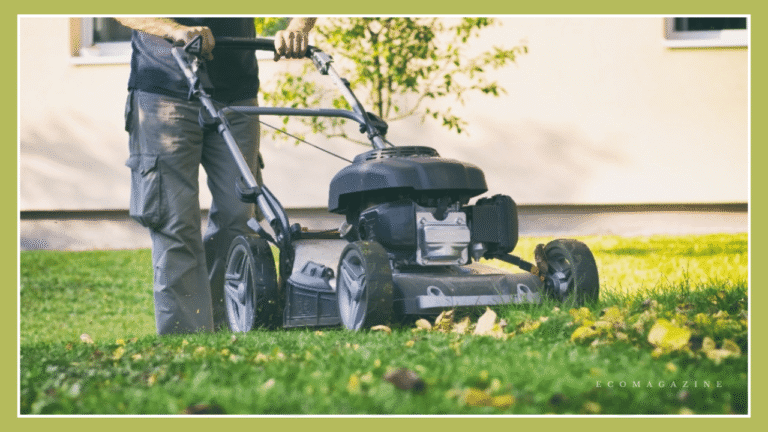As the summer fades and the crispness of autumn begins to settle in, our gardens start their gentle shift into a slower, sleepier season. For eco-conscious homeowners, this is the perfect time to show a little care not just for the lawn, but for the environment too. Preparing your garden and lawn mowers for autumn doesn’t have to be a chore – it’s about making smart, sustainable swaps that protect your outdoor space, support local wildlife, and ensure your garden tools last for years to come.
Slow the Mow – Caring for Lawn and Machine Alike
As the temperature drops and daylight shortens, grass growth naturally slows, meaning you can reduce your mowing schedule to once every two or three weeks. This lighter approach not only saves energy but also helps your lawn develop stronger roots before winter sets in.
Before putting your lawn mowers to rest for the season, give them a bit of TLC. Remove any built-up grass clippings from the underside of the deck, check the blades for sharpness, and clean or replace the air filter if needed. Electric mower users should inspect cables for wear, while petrol models may benefit from draining old fuel to prevent clogging.
If you’re upgrading your mower, look for energy-efficient or battery-powered models that use less electricity and produce zero emissions. Many newer designs even feature quiet motors, which are kinder to both your ears and local wildlife.
As you wind down mowing duties, leave your grass around 5 cm in height before the first frost. The extra length provides natural insulation, helping your lawn retain moisture and nutrients through the winter.
Sustainable Garden Transitions – Nurture, Don’t Neglect
Autumn may seem like a time to pack away your gardening tools, but in reality, it’s a crucial moment to prepare your garden for the months ahead. With a few eco-friendly habits, you can turn this seasonal shift into an opportunity for growth.
Start by clearing away fallen leaves, but don’t throw them in the bin. Instead, create a leaf mould pile or compost heap. Leaf mould breaks down into a nutrient-rich soil conditioner that’s perfect for spring planting. A simple wire cage or old compost bin works wonders, and it saves countless bags of green waste from heading to landfill.
Next, take a look at your soil. Autumn rains can compact the ground, reducing drainage and making it harder for roots to breathe. Gently aerate your lawn using a garden fork, then add a natural top dressing of compost or loam to replenish nutrients. Skip chemical fertilisers – they often leach into groundwater and harm beneficial insects. Organic compost does the same job naturally.
Your garden borders also deserve attention. Cut back perennials that have finished flowering, but leave seed heads from plants like echinacea, teasels, and sunflowers intact. They provide food and shelter for birds throughout the colder months. Similarly, resist the urge to tidy everything too much. A bit of messiness creates micro-habitats for hedgehogs, frogs, and pollinators overwintering in your garden.
Watering can be reduced, though not abandoned completely. Use collected rainwater where possible. It’s softer, more sustainable, and helps reduce household water consumption. Installing a simple water butt can make a big difference in maintaining an eco-friendly garden routine.
Tools, Wildlife, and the Human Touch – A Greener Autumn Mindset
Once your garden and mower are prepped, autumn becomes a time for reflection. Think of it as your garden’s version of a reset.
Store your gardening tools and lawn mowers properly to protect them from rust and damp. A dry shed or garage with proper garage storage racks or hooks keeps equipment in good condition for spring. A little organisation now means less clutter later, and it ensures that tools last longer, saving you money and waste.
Autumn is also a brilliant time to create or improve wildlife habitats. Pile up logs in a shady corner to offer a home for beetles and hedgehogs or hang a bug hotel near a hedge. If you’ve pruned bushes or trees, stack the trimmings neatly to provide shelter for insects and small mammals. These simple steps encourage biodiversity and bring your garden to life, even during its quieter months.
When it comes to eco-friendly lawn and garden care, one of the easiest wins is reducing waste. Compost your organic matter, recycle pots, and repurpose containers where possible. Even small habits, like sharpening old shears instead of replacing them, contribute to a more sustainable household.
And don’t forget the human element. Spending time in your garden during autumn can do wonders for mental wellbeing. Raking leaves, trimming hedges, and simply breathing in the cool, earthy air connects us to the natural rhythms of the season. A well-kept outdoor space, no matter how small, becomes a sanctuary of calm and accomplishment.
If you’re inspired to take your sustainability a step further, consider redesigning your garden with long-term eco-principles in mind. Introduce drought-tolerant plants, install solar-powered lighting, and choose local materials for paths and patios.
Preparing your garden and mower for autumn is an act of care for your home, your environment, and your wellbeing. By taking simple steps such as maintaining your lawn mowers, composting naturally, and protecting wildlife habitats, you create a space that will reward you when spring returns.


